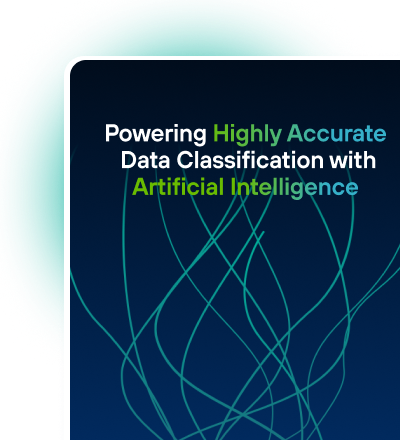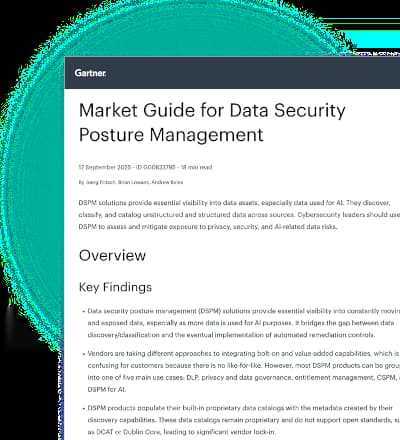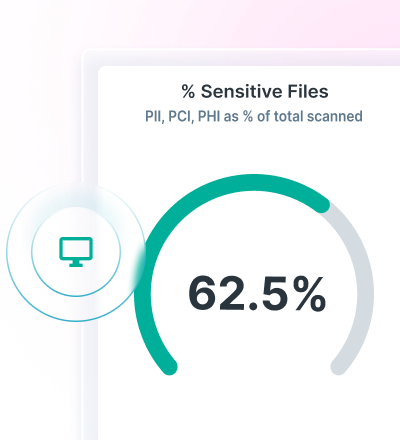Top Data Access Governance Tools and How to Choose the Best
0 minutos de leitura

Tim Herr
In 2025, data protection is no longer just about preventing leaks. The real challenge is knowing who can access sensitive data, where that data lives and how it is being used.
As organizations expand into multi-cloud and hybrid environments, maintaining control over access has become a cornerstone of modern security and compliance strategies.
Various Data Access Governance (DAG) vendors help solve this problem. They provide visibility into how data moves across cloud services, endpoints and collaboration platforms, and help organizations enforce least privilege and compliance policies at scale. These tools bridge the gap between visibility and control, a challenge we solve through the Forcepoint Data Security Cloud, which unifies multiple technologies into one integrated platform.
How We Compared Data Access Governance Tools
Our comparison of leading Data Access Governance solutions is based on a review of each vendor’s current product capabilities as of Q3 2025. The analysis draws from publicly available datasheets, analyst papers and vendor documentation, as well as Forcepoint’s own evaluations of cross-portfolio integrations and real-world use cases.
To keep the comparison fair, we focused only on each vendor’s native capabilities and the most recent versions available as of publication.
Each solution was evaluated against six key criteria central to modern DAG and Data Security Posture Management (DSPM) programs: AI-based classification, ROT analysis, integrations with DLP and CASB, automation, analytics and deployment flexibility.
This approach helps readers understand how Forcepoint, Varonis, BigID, Securiti, Concentric AI, Cyera and Microsoft compare in visibility, automation and compliance effectiveness across hybrid cloud environments.
The Best Data Access Governance Tools for 2025
Below we compare seven leading data access governance solutions. Each is evaluated based on its top features, strengths, weaknesses and ideal use cases.
1. Forcepoint
Forcepoint delivers DAG through an integrated platform rather than a single product. Forcepoint Data Security Cloud unites several core technologies to automate discovery, classification, access control. monitoring and enforcement across distributed environments:
- Data Security Posture Management (DSPM)
- Data Detection and Response (DDR)
- Data Loss Prevention (DLP)
- Cloud Access Security Broker (CASB)
Together, these capabilities form the foundation of Forcepoint’s Data Access Governance solution, operationalizing continuous monitoring, risk reduction and compliance across data wherever it resides.
Top Features
Unified policy enforcement through Forcepoint Data Security Cloud
- AI-powered data discovery and classification
- Real-time access monitoring and adaptive controls
- Integration across cloud, endpoint and SaaS environments
- Risk scoring and behavioral analytics
Pros
- Unified platform consolidates governance functions
- Automated risk-based responses
- Deep visibility across hybrid environments
Cons
- Enterprise-grade flexibility may require thoughtful configuration
Ideal For: Organizations seeking to unify governance and protection across data silos without stitching together multiple standalone tools.
2. Varonis
Varonis provides a data security platform for discovery, classification and access governance across unstructured and structured data. Its tools automate permission reviews, remediate excessive access and deliver detailed reporting for compliance and audit needs.
Top Features
- File and email permission auditing
- Automated remediation of excessive permissions
- Real-time alerts on data misuse
Pros
- Deep visibility into unstructured data
- Strong reporting capabilities
Cons
- Primarily focused on on-premises and Microsoft environments
- Limited native Data Security Posture Management capabilities
Ideal for organizations seeking detailed access visibility for legacy and Microsoft infrastructure.
3. BigID
BigID delivers data discovery and governance across cloud and on-premises environments. Its platform supports privacy, compliance and access monitoring, helping organizations enforce least privilege and identify data risk at scale.
Top Features
- Advanced data discovery and classification
- Strong privacy and compliance features
- Integrations with cloud and SaaS platforms
Pros
- Excellent data catalog and compliance management
- Strong support for multi-cloud environments
Cons
- Complex setup and tuning for large-scale deployments
Ideal for data teams focused on privacy, compliance and DSPM initiatives.
4. Securiti
Securiti offers an AI-driven data governance platform that unifies privacy, security and access management. Its Data Access Intelligence module maps entitlements, automates least privilege and governs how users and AI systems access sensitive data.
Top Features
- Unified data intelligence for privacy and security
- AI-driven discovery of sensitive data
- Integrated consent and governance management
Pros
- Excellent privacy and compliance focus
- Easy-to-use dashboard
Cons
- Limited focus on behavioral risk analytics
Ideal for organizations prioritizing data privacy and consent automation.
5. Concentric AI
Concentric AI uses machine learning to identify and protect sensitive data across cloud and collaboration tools. Its platform automates data classification, monitors permissions and provides policy recommendations to reduce risk.
Top Features
- Autonomous data risk discovery
- AI-driven content and context analysis
- Automatic access recommendations
Pros
- Lightweight and scalable AI approach
- Rapid deployment
Cons
- Fewer integrations than enterprise-grade platforms
Ideal for companies seeking quick AI-powered insights into data risk exposure.
6. Cyera
Cyera provides a cloud-native data security platform focused on discovery, classification and access analysis. It maps sensitive data across cloud and SaaS environments, highlights overexposed assets and supports automated least-privilege enforcement for compliance and risk reduction.
Top Features
- Real-time data mapping across cloud and SaaS
- Automated least-privilege enforcement
- Visibility into overexposed assets
Pros
- Cloud-native deployment
- Strong automation capabilities
Cons
- Limited functionality for on-premises systems
Ideal for organizations with large multi-cloud deployments seeking automated access control and visibility.
7. Microsoft Purview
Microsoft Purview centralizes data discovery, cataloging and compliance across the Microsoft 365 ecosystem. It manages classification, labeling and metadata-driven governance but relies on integration with other tools for full access control coverage.
Top Features
- Data classification and labeling
- Compliance management tools
- Deep integration with Microsoft 365
Pros
- Seamless Microsoft 365 integration
- Familiar interface for IT teams
Cons
- Limited visibility into non-Microsoft systems
- Manual tuning required for cross-platform governance
Ideal for enterprises invested in Microsoft ecosystems.
What Are the Main Features of a Data Access Governance Tool?
An effective DAG tool connects discovery, classification and enforcement. Key capabilities include:
- Data Classification: Automatically identifies and categorizes data by sensitivity level, ownership and location, enabling better policy enforcement.
- Compliance and Policy Enforcement: Ensures data handling aligns with frameworks such as GDPR, HIPAA and ISO 27001 by applying consistent policies across environments.
- Access Controls: Monitors and adjusts permissions to ensure users only access what’s necessary for their roles.
- Risk Insights: Provides continuous visibility into data exposure and unusual access behaviors to detect potential insider or external threats.
- Integrations: Connects with cloud services, collaboration tools and identity management systems to deliver unified data protection coverage.
How to Choose the Right Data Access Governance Solution for Your Business
The right Data Access Governance (DAG) tool depends on your architecture, compliance requirements and operational goals. Consider these key factors:
- Cloud Scalability: Ensure your platform can extend visibility and control across multiple clouds and hybrid environments as your data grows.
- Meaningful Reporting: Look for intuitive dashboards that transform technical data into actionable insights for governance, compliance and security teams.
- Automated Access Controls: The best tools continuously evaluate user permissions and adjust them based on real-time data risk levels.
- Integration Depth: Opt for solutions that integrate natively with your identity, Data Loss Prevention (DLP) and Data Security Posture Management (DSPM) systems. Forcepoint excels here through its Data Security Cloud, which unites these elements within one architecture.
- Ease of Deployment: A DAG solution should offer low-friction deployment with clear APIs and minimal disruption to workflows.
The Forcepoint Data Security Cloud allows organizations to automate governance at scale, turning reactive data management into proactive risk control. Read the full Guide to Data Access Governance.
Data Access Governance Solutions FAQ
- What are data governance tools? They are solutions that help define, enforce and monitor policies for how data is accessed, shared and protected.
- What is the difference between DAG and DSPM? DAG focuses on who can access data and how permissions are managed while DSPM focuses on where data resides and its security posture across cloud assets. Together they provide full lifecycle protection.
- What is the difference between data governance and DLP? Data governance manages policies and permissions, while Data Loss Prevention (DLP) enforces those policies by preventing data exfiltration or misuse.
- What are the top data governance frameworks? Popular frameworks include DAMA-DMBOK, COBIT and ISO 38505-1 for structured governance, risk management and compliance.
Conclusion
Data Access Governance tools are now mission-critical for secure and compliant data management. While many platforms specialize in visibility or compliance, Forcepoint’s integrated DSPM, DLP, DDR and CASB capabilities within the Data Security Cloud uniquely deliver unified discovery, policy and enforcement, helping organizations stay ahead of both threats and regulations.
No matter which platform you choose, success depends on unifying visibility and control. Forcepoint’s integrated approach helps teams do both through a single, adaptive data security architecture.
Learn more about Forcepoint’s Data Access Governance approach.

Tim Herr
Leia mais artigos de Tim HerrTim serves as Brand Marketing Copywriter, executing the company's content strategy across a variety of formats and helping to communicate the benefits of Forcepoint solutions in clear, accessible language.
 How to Strengthen Data Access Governance with Forcepoint DSPMAssistir ao Vídeo
How to Strengthen Data Access Governance with Forcepoint DSPMAssistir ao Vídeo
X-Labs
Receba insights, análises e notícias em sua caixa de entrada

Ao Ponto
Cibersegurança
Um podcast que cobre as últimas tendências e tópicos no mundo da cibersegurança
Ouça Agora








